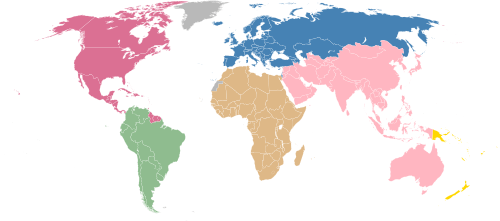Libya women's national football team
| Association | Libyan Football Federation | ||
|---|---|---|---|
| Confederation | CAF (Africa) | ||
| Sub-confederation | UNAF (North Africa) | ||
| FIFA code | LBY | ||
| |||
| FIFA ranking | |||
| Current | NR (26 August 2016) | ||
| First international | |||
|
(Sousse, Tunisia, March 6, 2016) | |||
| Biggest defeat | |||
|
(Sousse, Tunisia, March 6, 2016) | |||
The Libya women's national football team is the national football team of Libya. It does not have FIFA recognition. It is not ranked by FIFA. There are development plans in the country to improve the state of women's football.
The team
In 1985, almost no country in the world had a women's national football team,[1] including Libya who have not played in a FIFA sanctioned match As of June 2012.[2] In 2006, a FIFA recognised senior A team did not official exist.[3] In 2010, the country did not have a team competing in the African Women's Championships.[4] The country did not have a team competing at the 2011 All Africa Games.[5] As of June 2012, a team from Libya was not ranked in the world by FIFA.[6]
Background and development
Early development of the women's game at the time colonial powers brought football to the continent was limited as colonial powers in the region tended to take make concepts of patriarchy and women's participation in sport with them to local cultures that had similar concepts already embedded in them.[7] The lack of later development of the national team on a wider international level symptomatic of all African teams is a result of several factors, including limited access to education, poverty amongst women in the wider society, and fundamental inequality present in the society that occasionally allows for female specific human rights abuses.[8] When quality female football players are developed, they tend to leave for greater opportunities abroad.[9] Continent wide, funding is also an issue, with most development money coming from FIFA, not the national football association.[9] Future success for women's football in Africa is dependent on improved facilities and access by women to these facilities. Attempting to commercialise the game and make it commercially viable is not the solution, as demonstrated by the current existence of many youth and women's football camps held throughout the continent.[7]
The women's game is severely underdeveloped in Libya. A project was in development in 2004 to try to improve the state of the game for women, mirroring a similar project done in Afghanistan.[10] In 2006, there were 0 registered female players in the country.[3] That year, a committee was under development to better register and track female footballers.[3] In 2006, there were no women's teams in the country.[3] Football is played by girls aged 9 to 18 in school.[3] There were 0 registered female futsal players in 2006 though there are some unregistered female futsal players in the country.[3] Rights to broadcast the 2011 Women's World Cup in the country were bought by Al Jazeera and Eurosport.[11]
The national federation was created in 1962 and joined FIFA in 1964.[3] Their kid includes green shirts, white shorts and green socks.[12] In 2006, there were three staff members dedicated to working on women's football in the country.[3]
Competitive record
African Women's Championship record
| African Women's Championship | |||||||||
|---|---|---|---|---|---|---|---|---|---|
| Appearances: 0 | |||||||||
| Year | Round | Position | Pld | W | D | L | GF | GA | GD |
| 1991 | Did not enter | ||||||||
| 1995 | |||||||||
| Withdrew | |||||||||
| Did not enter | |||||||||
| Did not qualify | |||||||||
| Total | 0/12 | ||||||||
References
- ↑ Chrös McDougall (1 January 2012). Soccer. ABDO. p. 45. ISBN 978-1-61783-146-1. Retrieved 13 April 2012.
- ↑ "Libya Fixtures". FIFA. Retrieved 10 June 2012.
- 1 2 3 4 5 6 7 8 FIFA (2006). "Women's Football Today" (PDF): 116. Retrieved 8 June 2012.
- ↑ "Fixtures — African Women Championship 2010 - CAF". Cafonline.com. Retrieved 2012-04-13.
- ↑ "Groups & standings — All Africa Games women 2011 - CAF". CAF. Retrieved 2012-04-13.
- ↑ "The FIFA Women's World Ranking". FIFA.com. 2009-09-25. Retrieved 10 June 2012.
- 1 2 Peter Alegi (2 March 2010). African Soccerscapes: How a Continent Changed the World's Game. Ohio University Press. ISBN 978-0-89680-278-0. Retrieved 22 April 2012.
- ↑ Jean Williams (15 December 2007). A Beautiful Game: International Perspectives on Women's Football. Berg. p. 186. ISBN 978-1-84520-674-1. Retrieved 13 April 2012.
- 1 2 Gabriel Kuhn (24 February 2011). Soccer Vs. the State: Tackling Football and Radical Politics. PM Press. p. 34. ISBN 978-1-60486-053-5. Retrieved 13 April 2012.
- ↑ Hubbard, Alan (October 10, 2004). "Inside Lines: Girl power kicks off successfully in Kabul". The Independent on Sunday. London, England. p. 2. Retrieved 16 April 2012.
- ↑ "FIFA Women's World Cup Germany 2011TM Media Rights Licensees" (PDF). FIFA. 2011. Retrieved 21 April 2012.
- ↑ Pickering, David (1994). The Cassell soccer companion : history, facts, anecdotes. London: Cassell. p. 172. ISBN 0304342319. OCLC 59851970.
